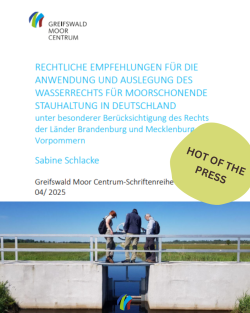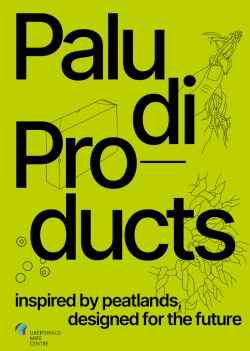News
2025
3 new funding programmes for paludiculture projects
by Berit Krondorf (comments: 0)
Ideas can be submitted until the end of January 2026.
Paludiculture in practice, young scientists, water and nutrient management – new calls for proposals will be issued in October.
10/11/2025 The Federal Ministry of Agriculture, Food and Rural Affairs (BMLEH) wants to further promote climate protection through peatland conservation and is intensifying its research funding. The three calls for funding address paludiculture management techniques, water and nutrient management, and young scientists.
Funding for ‘‘Research into innovative cultivation techniques for paludiculture“ is intended to support practical research with rapidly available technology and knowledge transfer in the field of land management and the extraction of renewable raw materials from paludiculture. The Ministry is offering young researchers up to five years of funding for the collection and modelling of data on rewetted moorland sites. Funding for „Water and nutrient management of paludiculture“ is intended to generate knowledge on the hydrology and nutrient supply of wet moors and paludiculture at the regional level.
New legal opinion
by Berit Krondorf (comments: 0)
for peatland-friendly water management

27/10/2025 Peatlands play a key role in climate protection, but their rewetting often fails or is complicated due to legal hurdles and regulatory frameworks. A new opinion paper entitled “Legal recommendations and interpretation of water law for peatland-friendly water management in Germany” prepared by Prof. Dr. Sabine Schlacke, analyzes how water law in Germany needs to be adapted, particularly for sustainable peatland use. The key message: peatland-friendly water management is essential for the preservation of peatlands as CO₂ reservoirs and for adaptation to climate change, and must therefore be promoted – especially in the federal states of Brandenburg and Mecklenburg-Western Pomerania. The report contains recommendations for action by politicians and administrators to create legal certainty for land users and nature conservation.
The recommendations in the report are particularly relevant for Mecklenburg-Western Pomerania, as the Ministry of Agriculture has presented a draft amendment to the state water law, which is currently being discussed by the committees of the state parliament. This presents an opportunity to include provisions to facilitate procedures for peatland rewetting.
The report is aimed at decision-makers in politics, administration, and agriculture and shows concrete ways in which water law can better support peatland conservation measures. It is a publication of the GMC proceedings, developed in the MoKKA project by the University of Greifswald the Succow Foundation.
InAWi and 1000Moore
by Berit Krondorf (comments: 0)
Training for both funding programmes
13/10/2025 InAWi and 1000Moore are two funding guidelines with which the Federal Environment Ministry supports projects for the rewetting of peatland soils.
Applicants can find out more in two online training courses:
InAWi: 10 November 2025, 10:00 a.m. – 12:00 p.m. (registration until 7 November)
1,000 Moors: 18 November 2025, 9:30 a.m. – 11:30 a.m. (registration until 7 November)
The events are also aimed at participants who already attended an applicant training course in autumn 2024. The team at the project management agency Zukunft – Umwelt – Gesellschaft (ZUG) gGmbH will share their experiences and helpful tips from the first year of the funding programmes.
Peatlands at Futurium
by Berit Krondorf (comments: 0)
Join the discussion on October 9!

3/10/2025 “More peatlands! But how?” – Futurium, the Joachim Herz Foundation, and the Greifswald Mire Centre are hosting an event under this title on October 9 in the heart of Berlin. Peatlands are key CO₂ reservoirs and, at the same time, controversial interests concerning land use. How can climate protection, agriculture, and local interests be reconciled? This question will be the focus of the expert discussion with visitor participation. from 19:30 p.m.
Moderator Katie Gallus will talk to:
• Lucas Gerrits, co-founder and managing director of Zukunft Moor GmbH
• Juliane Petri, farmer and agricultural consultant from Rhinluch/Kremmen
• Dr. Franziska Tanneberger, Director of the Greifswald Mire Centre
• René Seltmann, Agricultural Consultant for Peatland Protection at the Brandenburg State Office for the Environment (LfU)
The event at Futurium, Alexanderufer 2 in Berlin, is free of charge, but registration is required.
Superfresh: the first ever
by Berit Krondorf (comments: 0)
Paludi Product Catalogue

24/09/2025 Freshly launched at RRR2025 conference : The first ever Paludi Product Catalogue! With as many pilot products, prototyps and services related to paludiculture as we could assemble. The aim is to provide a comprehensive over view and to show how diverse, innovative and marketable this new form of land use already is today.
To showcase the innovative potential of this field and highlight the diversity of existing products the catalogue is intended for:
• Farmers – to demonstrate the existing demand for paludiculture biomass across a wide range of products.
• Companies – that already process paludiculture biomass or plan to do so, offering inspiration and opportunities for networking
• Research, policymakers, and society
What makes it special: It is open to further contributions and will be regularly updated and expanded in the future. All new and existing Paludi products can be included.
The catalogue is launched at the "Renewable Resources from Wet and Rewetted Peatlands - 4th International Conference on the Utilisation of Wetland Plants", which is part of the project PaludiZentrale











